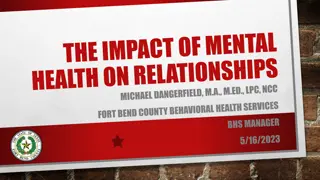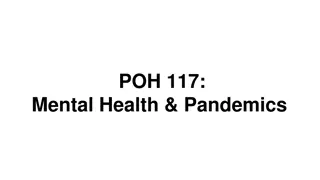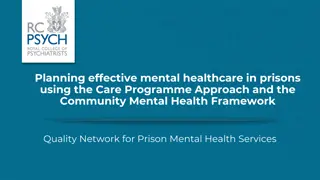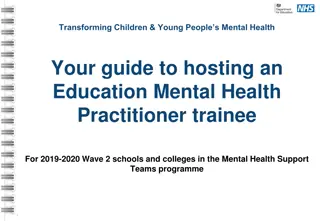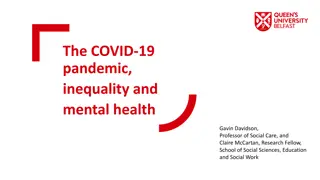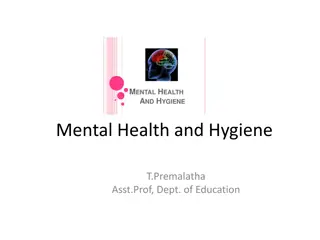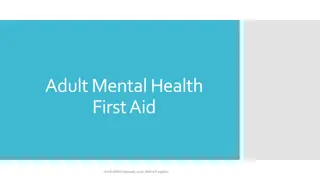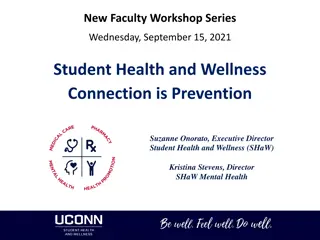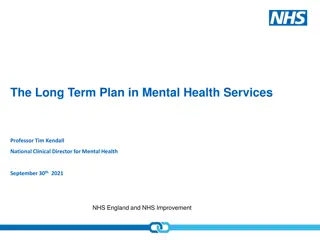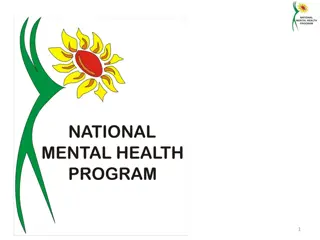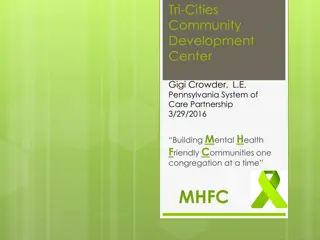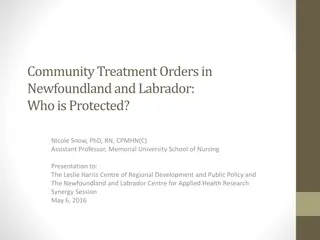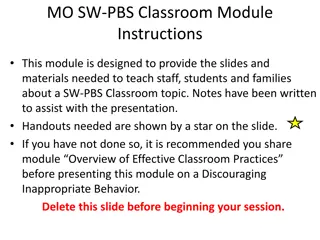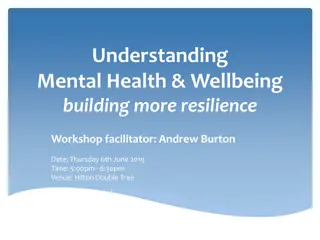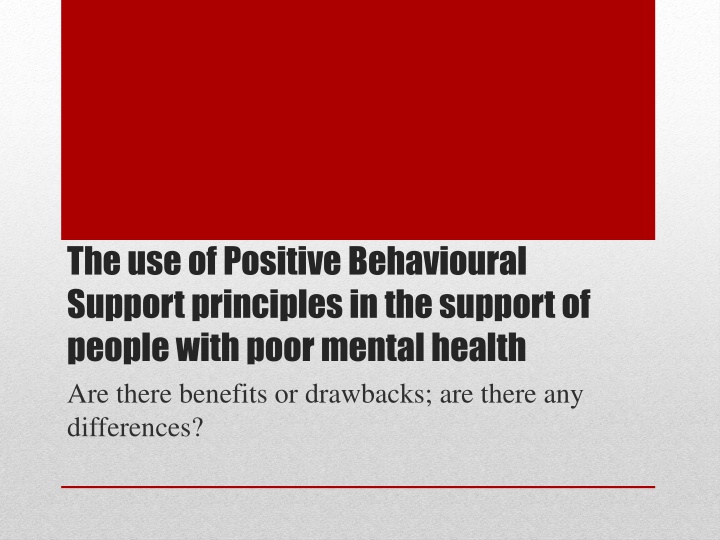
Benefits and Drawbacks of Positive Behavioural Support Principles for Mental Health Support
Positive Behavioural Support (PBS) principles are practical and effective methods to address challenging behaviors in individuals with poor mental health. These principles focus on understanding the reasons behind challenging behaviors, modifying the environment, teaching new skills, and improving quality of life. While PBS offers proactive, developmental, and multicomponent approaches, it also emphasizes stakeholder involvement and long-term strategies. By promoting inclusive and participatory practices, PBS aims to prevent and reduce challenging behaviors while enhancing quality of life and social roles. Stakeholder participation plays a crucial role in informing and validating assessment and intervention practices within the PBS framework.
Download Presentation

Please find below an Image/Link to download the presentation.
The content on the website is provided AS IS for your information and personal use only. It may not be sold, licensed, or shared on other websites without obtaining consent from the author. If you encounter any issues during the download, it is possible that the publisher has removed the file from their server.
You are allowed to download the files provided on this website for personal or commercial use, subject to the condition that they are used lawfully. All files are the property of their respective owners.
The content on the website is provided AS IS for your information and personal use only. It may not be sold, licensed, or shared on other websites without obtaining consent from the author.
E N D
Presentation Transcript
The use of Positive Behavioural Support principles in the support of people with poor mental health Are there benefits or drawbacks; are there any differences?
Positive behavior support (PBS) is an applied science that uses educational and systems change methods (environmental redesign) to enhance quality of life and minimize problem behaviors Carr et al (2002) What is Positive Behaviour Support?
Applied Behaviour Analysis Normalisation/ Inclusion Movement Person Centred Values Sources of PBS (Carr et al 2002)
comprehensive lifestyle change a lifespan perspective ecological validity stakeholder participation social validity systems change and multicomponent intervention emphasis on prevention, Feature of PBS (Carr et al 2002)
PBS is practical and effective means of responding to the challenges posed by problem behaviours by Developing and understanding of why a person presents with challenging behaviour. Making changes to the environment, thus reducing the need for challenging behaviour to occur Developing alternative ways to prevent the behaviours occurring by teaching the person new skills Respecting the person PRTC Training manual (2014) What is PBS?
Proactive approaches Developmental approaches Involving stakeholders Necessity for long term approach Multicomponent approach Focus on Quality of Life Functional Analysis Data collection Important principles
Prevention and reduction of challenging behaviour occurs within the context of increased quality of life, inclusion, participation, and the defence and support of valued social roles Constructional approaches to intervention design build stakeholder skills and opportunities and eschew aversive and restrictive practices Stakeholder participation informs, implements and validates assessment and intervention practices PBS values
An understanding that challenging behaviour develops to serve important functions for people The primary use of applied behaviour analysis to assess and support behaviour change The secondary use of other complementary, evidence- based approaches to support behaviour change at multiple levels of a system PBS THEORY & EVIDENCE BASE
A data-driven approach to decision making at every stage Functional assessment to inform function-based intervention Multicomponent interventions to change behaviour (proactively)and manage behaviour (reactively) Implementation support, monitoring and evaluation of interventions over the long term PBS PROCESS
There is a strong evidence base for the use of PBS for people with intellectual impairment or learning disabilities and we would also advocate the use of this model for people with other needs, such as people who have dementia and people with mental health needs Positive and Proactive Workforce (Skills For Care)
The introduction of PBS or similar principles in a systematic, organisation-wide context is an important mechanism by which to deliver the key elements associated with restrictive interventions programmes Positive and Proactive Care- reducing the need for restrictive practices
Mental ill health is a significant risk factor for challenging behaviour in people with learning disabilities or dementia (PRTC manuals 2014) Implies that poor mental health is one of many potential risk factors for challenging behaviour Current usage
Positive Behavioral Support Planning in the Inpatient Treatment of Severe Disruptive Behaviors: A Description of Service Features Nakia M. Hamlett, Erika R. Carr, and Marc Hillbrand Psychological Services 2016 Vol. 13, No. 2,178 182 PBS planning seen as a more effective alternative to the use of restraint, seclusion, restriction and punitive practices Importance of functional analysis, antecedents, consistency of approach Article focusses on how to introduce PBS in an out patient setting Acknowledgement of the current limitations of the evidence for the use of PBS in these settings However the case vignette presents good qualitative evidence Current Research/Evidence
An Integrated Approach to Universal Prevention: Independent and Combined Effects of PBIS and SEL on Youths Mental Health Clayton R. Cook, Megan Frye, Tal Slemrod, Aaron R. Lyon, Tyler L. Renshaw School Psychology Quarterly 2015, Vol. 30, No. 2, 166 183 PBIS =Positive Behavioral Interventions and Supports SEL= Social Emotional Learning Article is a about a research based study on the effectiveness of use of the above with students who have poor mental health Current Research/Evidence
Mental health Intervention Teams: A Collaborative Model to Promote Positive Behavioral Support for Youth with Emotional or Behavioral Disorders. Katina M. Lambros; Shirley K. Culver and Aidee AnguloThe California School Psychologist, Vol. 12, pp. 59 71, 2007 Research on the use of positive behaviour supports with adolescents who have emotional and behavioural problems and poor mental health Current Research/Evidence
Kristine Jolivette , Dashaunda P. Patterson , Nicole Cain Swoszowski, Sara C. McDaniel, Christina Kennedy & Robin Parks Ennis (2014) School-Wide Positive Behavioral Interventions and Supports in a Residential School for Students With Emotional and Behavioral Disorders: First Years of Implementation and Maintenance Follow-Up Focus Groups, Residential Treatment For Children & Youth, 31:1, 63-79 The use of Positive behavioural interventions and supports with students in a residential school. More school wide rather than individual Expectations Matrix rules/reinforcements Emotional and behavioural disorders- mental health not cited Succesful Current Research/Evidence
A Person-Centered, Strength-Based Treatment of Aggression and Sexually Inappropriate Behavior in Mental HealthAshvind N. Singh Paul S. Strand Clinical Case Studies Volume 7 Number 5 October 2008 397-408 Complexity of individual whose case is explored in the article Promotes strengths based approaches and functional analysis function of sexual inappropriateness Changes in environment and approach (glasses, morning greetings) Education- perception of masculinity Anger management and stress relief training Successful Current Research/Evidence
Behavioral consultation within a psychiatric hospital setting. Moravecek, Michael J.; the Behavior Therapist, Vol 38(8), Win 2015 pp. 256-258. Abstract: This article discusses Connecticut Valley Hospital Behavioral Intervention Service (CVH BIS). The CVH BIS is a relatively novel approach to providing support that focuses on behavioral interventions to treatment teams within a public inpatient psychiatric hospital. The interventions provided by the BIS involve a variety of interventions that require intensive functional behavioral analysis. The BIS works with treatment teams to develop Positive Behavioral Support Plans (PBSPs), but their intervention goes beyond the initial analysis and plan development. The BIS provides staff training to support treatment integrity, data analysis to monitor patient progress, and ongoing consultation services that continually refine the PBSP to maximize the plan s effectiveness. PBSP to maximize the plan s effectiveness. The BIS is also fully integrated with CVH and the State of Connecticut s Department of Mental Health and Addiction Services (DMHAS), decreasing the hospital s reliance on as needed, case-specific consultation by outside providers who may not be familiar with, invested in, or able to effectively interact with the systems and administration issues that predominate the public psychiatric hospital setting. More evidence
Positive behavior supports for children with major mental illness: Working with teachers and parents.kAhlman, Chris; In: The school services sourcebook: A guide for school-based professionals. Franklin, Cynthia (Ed); Harris, Mary Beth (Ed); Allen-Meares, Paula (Ed); Publisher: Oxford University Press; 2013, pp. 169-177. [Chapter] Abstract: This chapter is written for those school-based practitioners who are called upon by parents and teachers to help them, often the frontline workers, to assess, intervene; and evaluate the educational needs and progress of their children or students who have major mental health disorders. A major mental health disorder is defined here as a disorder that is pervasive, chronic, and a lifelong condition. To accomplish the mandates of Response to Intervention (RTI) it is necessary to have a workable understanding of the issues facing students, teachers, and parents regarding major mental health disorders. The school-based practitioner is required to not only have some expertise on these disorders but also to support and inform parents and teachers so they are also equipped to be part of the educational team. Research shows us that parents' participation in their child's social, emotional, and academic growth is important for academic achievement (Taylor & Adelman, 2001). Research also informs us that trained, skilled, and committed teachers are essential to the success of evidence-based interventions (Lewis, Jones, Horner, & Sugai, 2010). While this chapter will focus on children labeled with childhood bipolar disorder and childhood schizophrenia, many of the resources and intervention strategies could be useful in working with other major disorders. Research on positive behavior supports (PBS) reinforces the notion that all members of the team (student, parents, teachers, social workers, administrators) need to be able to understand the student's educational needs and be able to implement programming in an environment that supports these interventions (Lewis et al, 2010). This chapter will first give context for identification and interventions with children with major mental health diagnoses by reviewing specific information on the identification of childhood bipolar disorder and childhood schizophrenia and new research on children exhibiting similar symptoms. Also covered here will be some specific suggestions for developing interventions. There are resources for sample individual education plans (lEPs). Included as well is a discussion of how these strategies might be useful for working with children with other major mental health issues. Finally, there will be a list of resources where all team members can learn more about issues important to them in their attempts to support the education of these students. More evidence
Evidence of recent severe stress, particularly a loss event or the threat of loss History of disturbed/violent behaviour History of misuse of substances or alcohol One or more of the above in combination with any of the following: cruelty to animals reckless driving history of bed-wetting loss of a parent before the age of 8 years Carers reporting service user s previous anger or violent feelings Previous expression of intent to harm others Evidence of rootlessness or social restlessness Previous use of weapons Male Previous dangerous impulsive acts Increasing age (65-70) Denial of previous established dangerous acts Severity of previous acts Decline in cognitive and adaptive skills Known personal trigger factors Depression/anxiety Verbal threat of violence Requiring personal care support Historical risk factors for CB in people who have poor mental health-from NICE guidelines; quoted in PRTC manual 2014
Misuse of substances and/or alcohol Drug effects (disinhibition, akathisia) Active symptoms of schizophrenia or mania, in particular: delusions or hallucinations focused on a particular person command hallucinations preoccupation with violent fantasy delusions of control (especially with a violent theme) agitation, excitement, overt hostility or suspiciousness Poor collaboration with suggested treatments Antisocial, explosive or impulsive personality traits or disorder Organic dysfunction Risk Factors for Aggressive Behaviour: Personal (Current) NICE Guidelines/PRTC manual
Extent of social support High-traffic areas Immediate availability of a potential Crowding weapon Noise Relationship to potential victim (for Younger, less experienced staff example, if difficulties in relationship are known) Male staff Access to potential victim High Expressed Emotion (family settings) Limit setting (for example, staff Confrontational Coping (staffed settings) members setting parameters for activities, choices, etc.) Specific environment or interpersonal risk factors
how to keep well at work signs that you are getting unwell again triggers that make you unwell what to do if you get unwell how to get back on track after you have been unwell. Royal College of Psychiatrists Wellness Recovery Action Planning
Wellness Toolbox Daily Maintenance Plan Triggers Early Warning Signs When Things are Breaking Down Crisis Plan Post Crisis Plan http://mentalhealthrecovery.com/wrap-is/ Elements of WRAP
Hope People who experience mental health difficulties get well, stay well and go on to meet their life dreams and goals. Personal Responsibility It s up to you, with the assistance of others, to take action and do what needs to be done to keep yourself well. Education Learning all you can about what you are experiencing so you can make good decisions about all aspects of you life. Self Advocacy Effectively reaching out to others so that you can get what it is that you need, want and deserve to support your wellness and recovery. Support While working toward your wellness is up to you, receiving support from others, and giving support to others will help you feel better and enhance the quality of your life. http://mentalhealthrecovery.com/wrap-is/ Key Recovery Concepts
Functional analysis as a counterbalance to diagnostic overshadowing. Impact of other conditions, including physical illness, autism, family dynamics, abuse history Impact of the environment-noise, crowding, routines, Significance of interactions- staff, family, other service users Personal experiences and reflections
Ability of service users to actively participate in PBS planning Ability to learn Less complexity; less incidence of CB? Need for sensitivity Resource constraints- staffing/buildings Level of staff understanding and application of PBS principles Personal experiences and reflections


